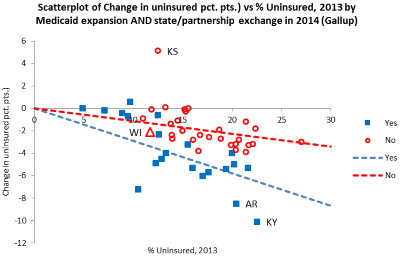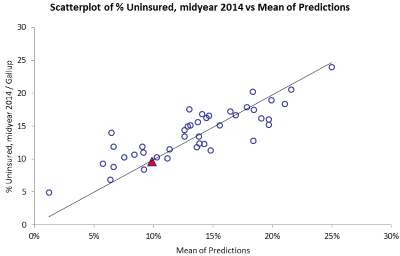Obamacare’s Success So Far
Uninsured rates decline in most states, more so for those “embracing” the legislation, and Wisconsin finds itself in the middle of the pack.

Former Health and Human Services Secretary Kathleen Sebelius and President Barack Obama.
How effective has the Affordable Care Act been in decreasing the ranks of the uninsured around the country and here in Wisconsin? On August 5, Gallup Healthways released its first state-by-state estimates since the provisions setting up health exchanges and encouraging states to expand Medicare took effect at the beginning of this year. These are the first such estimates based on actual polling, rather than economic models.
Gallup divides the states into two groups:
- Those “embracing” the Affordable Care Act by expanding Medicaid and setting up their own exchanges or creating a partnership with the federal government.
- States that have declined Medicare expansion and/or are using the federal exchange.
Gallup found that in states embracing the ACA, the average uninsured rate declined 4.0 percentage points, compared to 2.2 points in the remaining states. This is equivalent to a 25% reduction in the states embracing the ACA and a 12% reduction in the others.
A scatterplot of the state reductions versus last year’s uninsured rates is shown below. States embracing the ACA are shown with solid blue squares. The other states are shown with red circles. The dotted lines represent the trend for each group. Wisconsin is the red triangle.
As Gallup points out, states with the lowest uninsured rates before the ACA kicked in were most likely to embrace it. Ironically, states with the most uninsured were more likely to turn down federal funds for expanding Medicare.
The individual state results should be treated with a healthy dose of skepticism. Gallup estimates the margin of error is as high as +5 points for small states. Particularly for states that started with a low uninsured rate, any apparent changes may simply reflect sampling error.
With that caution in mind, it is useful to look at the results for several states:
- Wisconsin (red triangle) appears to fall between the two groups. Like the states embracing the ACA, it found a way to offer Medicare to people below the poverty line who didn’t have children. But like those opposed to the ACA, it didn’t accept federal money to expand Medicare and did not establish its own exchange.
- The state with a 5.1 point increase in uninsured is Kansas. This may be a sampling error, but Kansas has become a hotbed of ultra-conservative thought and legislation. Is there something about this political environment that also discourages enrollment in health care?
- Outliers in the other direction were Kentucky and Arkansas, the two states with the largest decline in uninsured rates. Both started with high uninsured rates but embraced the ACA. The outgoing Kentucky governor is well regarded for his crusade to provide more residents with health insurance.
Apparently, Gallup used the exchange decision as a proxy for the political establishment’s enthusiasm for the ACA. Was the ACA viewed as an opportunity or a threat? A regression analysis of Gallup’s “embrace” variable paints a more accurate picture than one only the Medicaid expansion decision. Rates of success increase if the people responsible for a project believe in it, so long as they are realistic.
The usefulness of the state exchange decision as a measurement of enthusiasm may not be relevant in the future. Oregon is using the federal exchange because it could not get its own to work. Several other states may switch as well because of web site problems.
Prior to the ACA kicking in, several organizations predicted each state’s rate of decline in the number of uninsured. How accurate were they? The second graph compares the average of predictions from four organizations with Gallup’s polling results. When it comes to the total number of people without insurance, there is overall agreement. Not surprisingly, there is much more variability when it comes to the change in each state. Wisconsin ended up being easy to predict.
Data Wonk
-
Life Expectancy in Wisconsin vs. Other States
 Dec 10th, 2025 by Bruce Thompson
Dec 10th, 2025 by Bruce Thompson
-
How Republicans Opened the Door To Redistricting
 Nov 26th, 2025 by Bruce Thompson
Nov 26th, 2025 by Bruce Thompson
-
The Connection Between Life Expectancy, Poverty and Partisanship
 Nov 21st, 2025 by Bruce Thompson
Nov 21st, 2025 by Bruce Thompson


















Notice something that no one mentions???? What happens 20 years from now to those states that expanded medicaid and the US reduce its reimbursement. 30 years ago some of us projected the costs of public employee pensions and benefits would bankrupt the states and that almost happened in Milwaukee county and Wisconsin and did to Ca. and Ill. Luckily Walker came along and fixed it, but these other states have not done that. Now in the case of Medicaid if you project normal growth and different levels of federal reimbursement you can see that this big medicaid bill will dwarf the ability of the states to pay for their schools. Answer? Adopt programs that reward thrift, cost containment, HSA’s etc., program promoted by Torinus. I will not be here, then, so hope that the youth pays attention.
For anyone reading this article, anywhere you see the word ‘Medicare,” substitute the word ‘Medicaid.’ It gets confusing. Medicare is the government operated insurance program that is provided for people when they reach the age of 65, or if they become eligible for Social Security Disability (SSDI).
Medicaid, which in Wisconsin is sometimes referred to as T-19, is the government provided insurance for low income people. Medicaid eligibility can get a little complicated so I will oversimplify. People who become disabled, but who have not worked long enough to be eligible for SSDI get SSI. Along with SSI, they get Medicaid insurance. It used to be that low income mothers with children who received AFDC also received Medicaid insurance. I think they and/or their children still do, but I do not understand the specifics. Perhaps another reader does. Again this is a little complicated, but elderly people who have exhausted their income resources paying for medical care, or nursing home care, can become eligible for Medicaid which then pays the costs for nursing home care.
To break it down in a crass way, Medicare is government provided health insurance that people across all income groups eventually get if they live long enough. Medicaid is government provided health insurance for people, who are low income to begin with, or because of ongoing medical care costs, become low income.
Overall, Medicare is very efficiently run, and has significantly lower administrative costs than private insurance. It is the model for those people who advocate for a universal single payer health care insurance system.
Again, I am by no means an expert on understanding, let alone explaining this stuff so I hope there is another reader who is.
All of these articles miss the major point. Where are we with this in 10-20 years based on normal growth and various changes in federal reimbursement. Many of us warned about where the pensions and health plans were going for public employees 30-40 years ago and it all came true. If you project the new Medicaid costs out 20 years and average growth with various changes in fed reimbursement and you see bankruptcy for states or no money for sch
ools.